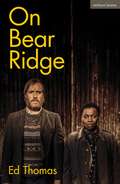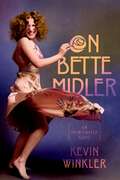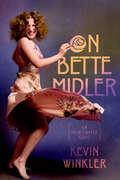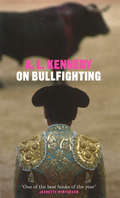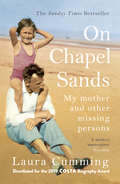- Table View
- List View
On Animation: The Director's Perspective Vol 2
by Ron DiamondOn Animation: The Director's Perspective is a collection of interviews with 23 animated feature-film directors. These extensive interviews were conducted over the past several years by filmmakers and educators (and peers to the directors interviews) Tom Sito and Bill Kroyer. Interviews cover in-depth discussion of each director's career -- focusing on their creative development, their films, lesson learned and advice. The interviews were edited and produced by Ron Diamond.Key FeaturesInterviews with the greatest living legends in animationOffers profound insight into the creative process of these giantsGrants advice and lessons for inspiring animators
On Architecture: Collected Reflections on a Century of Change
by Ada Louise HuxtableKnown for her well-reasoned and passionately held beliefs about architecture, Ada Louise Huxtable has captivated readers across the country for decades, in the process becoming one of the best known critics in the United States. Her brilliance over so many years is unmatched, and her range has always been vast-from a plea to save a particular architectural treasure to an ongoing discussion about whether modern architecture is dead. Her keen eye and vivid writing have reinforced to readers how important architecture is and why it continues to be both controversial and fascinating. Since so much of her writing has been in newspapers, it has quickly become unavailable to her many fans. On Architecture will bring together her best work from the New York Times, New York Review of Books, her more recent essays in the Wall Street Journal, and her various books. She is personally selecting and organizing the pieces into sections like "Art and Culture" and "The Art of Architecture," and is revising them as needed to bring them up to date. Whether you love modern architecture or desire a return to Beaux Arts design, this book will give you insight into the mind and heart of a critic who has artfully brought the discussion of architecture, architects and our environment to readers for five decades.
On Architecture: The Ten Books On Architecture (The\loeb Classical Library #251)
by VitruviusIn De architectura (c.40 BC), Vitruvius discusses in ten encyclopedic chapters aspects of Roman architecture, engineering and city planning. Vitruvius also included a section on human proportions. Because it is the only antique treatise on architecture to have survived, De architectura has been an invaluable source of information for scholars. The rediscovery of Vitruvius during the Renaissance greatly fuelled the revival of classicism during that and subsequent periods. Numerous architectural treatises were based in part or inspired by Vitruvius, beginning with Leon Battista Alberti's De re aedificatoria (1485).
On Art
by Ilya KabakovDuring the 1960s and 1970s, the Russian conceptual artist Ilya Kabakov was a galvanizing figure in Moscow's underground art community, ultimately gaining international prominence as the “leader” of a band of artists known as the Moscow Conceptual Circle. Throughout this time, he created texts that he would distribute among his friends, and by the late 1990s his written production amounted to hundreds of pages. Devoted to themes that range from the “cosmism” of pre-Revolutionary Russian modernism to the philosophical implications of Moscow’s garbage, Kabakov’s handmade booklets were typed out on paper, then stapled or sewn together using rough butcher paper for their covers. Among these writings are faux Socialist Realist verses, theoretical explorations, art historical analyses, accompaniments to installation projects, and transcripts of dialogues between the artist and literary theorists, critics, journalists, and other artists. This volume offers for the first time in English the most significant texts written by Kabakov. The writings have been expressly selected for this English-language volume and there exists no equivalent work in any language.
On Art
by Ilya KabakovDuring the 1960s and 1970s, the Russian conceptual artist Ilya Kabakov was a galvanizing figure in Moscow's underground art community, ultimately gaining international prominence as the “leader” of a band of artists known as the Moscow Conceptual Circle. Throughout this time, he created texts that he would distribute among his friends, and by the late 1990s his written production amounted to hundreds of pages. Devoted to themes that range from the “cosmism” of pre-Revolutionary Russian modernism to the philosophical implications of Moscow’s garbage, Kabakov’s handmade booklets were typed out on paper, then stapled or sewn together using rough butcher paper for their covers. Among these writings are faux Socialist Realist verses, theoretical explorations, art historical analyses, accompaniments to installation projects, and transcripts of dialogues between the artist and literary theorists, critics, journalists, and other artists. This volume offers for the first time in English the most significant texts written by Kabakov. The writings have been expressly selected for this English-language volume and there exists no equivalent work in any language.
On Art
by Ilya KabakovDuring the 1960s and 1970s, the Russian conceptual artist Ilya Kabakov was a galvanizing figure in Moscow's underground art community, ultimately gaining international prominence as the “leader” of a band of artists known as the Moscow Conceptual Circle. Throughout this time, he created texts that he would distribute among his friends, and by the late 1990s his written production amounted to hundreds of pages. Devoted to themes that range from the “cosmism” of pre-Revolutionary Russian modernism to the philosophical implications of Moscow’s garbage, Kabakov’s handmade booklets were typed out on paper, then stapled or sewn together using rough butcher paper for their covers. Among these writings are faux Socialist Realist verses, theoretical explorations, art historical analyses, accompaniments to installation projects, and transcripts of dialogues between the artist and literary theorists, critics, journalists, and other artists. This volume offers for the first time in English the most significant texts written by Kabakov. The writings have been expressly selected for this English-language volume and there exists no equivalent work in any language.
On Art
by Ilya KabakovDuring the 1960s and 1970s, the Russian conceptual artist Ilya Kabakov was a galvanizing figure in Moscow's underground art community, ultimately gaining international prominence as the “leader” of a band of artists known as the Moscow Conceptual Circle. Throughout this time, he created texts that he would distribute among his friends, and by the late 1990s his written production amounted to hundreds of pages. Devoted to themes that range from the “cosmism” of pre-Revolutionary Russian modernism to the philosophical implications of Moscow’s garbage, Kabakov’s handmade booklets were typed out on paper, then stapled or sewn together using rough butcher paper for their covers. Among these writings are faux Socialist Realist verses, theoretical explorations, art historical analyses, accompaniments to installation projects, and transcripts of dialogues between the artist and literary theorists, critics, journalists, and other artists. This volume offers for the first time in English the most significant texts written by Kabakov. The writings have been expressly selected for this English-language volume and there exists no equivalent work in any language.
On Art
by Ilya KabakovDuring the 1960s and 1970s, the Russian conceptual artist Ilya Kabakov was a galvanizing figure in Moscow's underground art community, ultimately gaining international prominence as the “leader” of a band of artists known as the Moscow Conceptual Circle. Throughout this time, he created texts that he would distribute among his friends, and by the late 1990s his written production amounted to hundreds of pages. Devoted to themes that range from the “cosmism” of pre-Revolutionary Russian modernism to the philosophical implications of Moscow’s garbage, Kabakov’s handmade booklets were typed out on paper, then stapled or sewn together using rough butcher paper for their covers. Among these writings are faux Socialist Realist verses, theoretical explorations, art historical analyses, accompaniments to installation projects, and transcripts of dialogues between the artist and literary theorists, critics, journalists, and other artists. This volume offers for the first time in English the most significant texts written by Kabakov. The writings have been expressly selected for this English-language volume and there exists no equivalent work in any language.
On Art
by Ilya KabakovDuring the 1960s and 1970s, the Russian conceptual artist Ilya Kabakov was a galvanizing figure in Moscow's underground art community, ultimately gaining international prominence as the “leader” of a band of artists known as the Moscow Conceptual Circle. Throughout this time, he created texts that he would distribute among his friends, and by the late 1990s his written production amounted to hundreds of pages. Devoted to themes that range from the “cosmism” of pre-Revolutionary Russian modernism to the philosophical implications of Moscow’s garbage, Kabakov’s handmade booklets were typed out on paper, then stapled or sewn together using rough butcher paper for their covers. Among these writings are faux Socialist Realist verses, theoretical explorations, art historical analyses, accompaniments to installation projects, and transcripts of dialogues between the artist and literary theorists, critics, journalists, and other artists. This volume offers for the first time in English the most significant texts written by Kabakov. The writings have been expressly selected for this English-language volume and there exists no equivalent work in any language.
On Art and Artists: An Anthology of Diderot's Aesthetic Thought
by Denis DiderotChance ordained that Denis Diderot (1713-1784) was not only a philosopher, playwright and writer, but also a salonnier. In other words, an art critic. In 1759, his friend Grimm entrusted him with a project that forced him to acquire "thoughtful notions concerning painting and sculpture" and to refine "art terms, so familiar in his words yet so vague in his mind". Diderot wrote artistic reviews of exhibitions – Salons – that were organized bi-annually at the Louvre by the Académie Royale de Peinture et de Sculpture. These reviews, published in the Correspondence Littéraire, were Diderot’s unique contribution to art criticism in France. He fulfilled his task of salonnier on nine occasions, despite occasional dips in his enthusiasm and self-confidence. Compiled and presented by Jean Szenec, this anthology helps the contemporary reader to familiarize himself with Diderot’s aesthetic thought in all its greatness. It includes eight illustrations and is followed by texts from Jean Starobinski, Michel Delon, and Arthur Cohen. ‘On Art and Artists’ is translated by John Glaus, professor of French and an amateur expert of the XVIIIth century.
On Art and Science: Tango of an Eternally Inseparable Duo (The Frontiers Collection)
by Shyam Wuppuluri Dali WuEinstein once remarked "After a certain high level of technical skill is achieved, science and art tend to coalesce in aesthetics, plasticity, and form. The greatest scientists are always artists as well". In this volume, some of the world’s leading thinkers come together to expound on the interrelations between sciences and arts. While one can segregate art and place it outside the scientific realm, it is, nevertheless, inextricably linked to our essential cognitive/emotional/perceptual modalities and abilities, and therefore lies alongside and in close contact with the method of science and philosophy. What inspiration can scientists draw from art and how can scientific spirit foster our understanding and creation of aesthetic works? How are art and science grounded in our cognition? What role does perception play in science and art? Are criteria for beauty in art and science the same? How does evolution shape our understanding of art? How do science, art and scientifico-artistic frameworks shape society as a whole and help us address its pressing issues? The epistemological and ontological aspects haunt artists, philosophers and scientists alike. The essays in this volume address these manifold questions while also elucidating the pragmatic role they play in our daily life.
On Art and War and Terror
by Alex DanchevThis book, a collection of Alex Danchev's essays on the theme of art, war and terror, offers a sustained demonstration of the way in which works of art can help us to explore the most difficult ethical and political issues of our time: war, terror, extermination, torture and abuse. It takes seriously the idea of the artist as moral witness to this realm, considering war photography, for example, as a form of humanitarian intervention. War poetry, war films and war diaries are also considered in a broad view of art, and of war. Kafka is drawn upon to address torture and abuse in the war on terror; Homer is utilised to analyse current talk of 'barbarisation'. The paintings of Gerhard Richter are used to investigate the terrorists of the Baader-Meinhof group, while the photographs of Don McCullin and the writings of Vassily Grossman and Primo Levi allow the author to propose an ethics of small acts of altruism. This book examines the nature of war over the last century, from the Great War to a particular focus on the current 'Global War on Terror'. It investigates what it means to be human in war, the cost it exacts and the ways of coping. Several of the essays therefore have a biographical focus.
On Artists (On Series)
by Ashleigh WilsonIf we denounce the artist, then what becomes of the work that remains?The #MeToo movement is overturning a cliché that has forgiven bad behaviour for years: to be creative is to be prone to eccentricity, madness, addiction and excess. No longer can artists be excused from the standards of conduct that apply to us all
On Aunty (On Series)
by Jonathan HolmesAustralia's public broadcaster, 'Aunty', is about to turn 90, yet your ABC has seldom been in this much trouble: budget cuts, ferocious political pressure, sagging staff morale, leadership chaos and hostile commercial rivals.Meanwhile audiences are deserting broadcast TV and radio. What is the ABC's place in this era of media disruption? Can it reach a younger audience on new platforms while still satisfying its loyal fans?
On Bear Ridge (Modern Plays)
by Ed ThomasOne minute we had customers, the next minute there was no-one.In a lost village, blurred by redrawn borders, hidden under a crumb on the map, Bear Ridge Stores still stands.After a hundred years, the family butchers and grocers – a place for odds and ends, contraband goods, and the last petrol pump for 30 miles – is now silent. But owners John Daniel and Noni are not leaving.They are defiantly drinking the remaining whiskey and remembering good times, when everyone was on the same side and the old language shone. Outside in the dark, a figure is making their way towards them.A semi-autobiographical story about the places we leave behind, the indelible marks they make on us, and the unreliable memories we hold onto.
On Bear Ridge (Modern Plays)
by Ed ThomasOne minute we had customers, the next minute there was no-one.In a lost village, blurred by redrawn borders, hidden under a crumb on the map, Bear Ridge Stores still stands.After a hundred years, the family butchers and grocers – a place for odds and ends, contraband goods, and the last petrol pump for 30 miles – is now silent. But owners John Daniel and Noni are not leaving.They are defiantly drinking the remaining whiskey and remembering good times, when everyone was on the same side and the old language shone. Outside in the dark, a figure is making their way towards them.A semi-autobiographical story about the places we leave behind, the indelible marks they make on us, and the unreliable memories we hold onto.
On The Beat: My Story
by Graham ColeGraham Cole has played PC Tony Stamp in hit television drama The Bill for nearly 25 years. Now he lifts the lid on his own life and reveals how he became one of Britain's best-loved TV cops. From growing up in London to patrolling the streets of fictional Sun Hill, Graham's story is witty and warm and reveals what life is like as a star of the country's favourite police drama.
On Bette Midler: An Opinionated Guide
by Kevin WinklerBette Midler today is a beloved legacy star, best known for her comic witch in Disney's Hocus Pocus (1993) and its 2022 sequel. She has also gained prominence for sentimental, anthemic ballads like "Wind Beneath My Wings," her initiation of green space projects in New York City, and tussling with Donald Trump on Twitter. Her profile is that of an articulate, civic-minded matriarch enjoying thoroughly mainstream stardom. But more than fifty years earlier she emerged from the steam of the subterranean Continental Baths as the Divine Miss M, the bawdy, campy, fearless alter ego she created in front of an audience of towel-clad gay men who came to the baths seeking not just sex, but a sense of community and safety from an often-harrowing outside world. "I was able to take chances on that stage that I could not have taken anywhere else," she later wrote. "Ironically, I was freed from fear by people who, at the time, were ruled by fear. And for that I will always be grateful." Overnight, Bette Midler became a much-loved icon of the gay community. The Divine Miss M coalesced gay, Jewish, feminist, and show business sensibilities into an outrageously funny and emotionally compelling persona that travelled with surprising ease from the cultural margins to the entertainment mainstream. Her embrace by mom-and-pop audiences, rock fans and critics, and the guardians of middle-of-the-road show business demonstrates just how deeply the tastes and sensibilities of her original audience have been absorbed into popular culture. On Bette Midler: An Opinionated Guide traces the early development of Midler's performing ethos from New York's downtown experimental theater scene and examines her impact across media, with chapters on the soaring highs (and occasional cringe-worthy lows) of her stage work, movies, recordings, and television appearances, and considers her influence as an environmental activist and social media presence. On Bette Midler features performance analysis and deeply researched background information, all of it supporting informed--and divinely opinionated--consideration of Midler the artist. It judges her work by the highest standards: those she established for herself.
On Bette Midler: An Opinionated Guide
by Kevin WinklerBette Midler today is a beloved legacy star, best known for her comic witch in Disney's Hocus Pocus (1993) and its 2022 sequel. She has also gained prominence for sentimental, anthemic ballads like "Wind Beneath My Wings," her initiation of green space projects in New York City, and tussling with Donald Trump on Twitter. Her profile is that of an articulate, civic-minded matriarch enjoying thoroughly mainstream stardom. But more than fifty years earlier she emerged from the steam of the subterranean Continental Baths as the Divine Miss M, the bawdy, campy, fearless alter ego she created in front of an audience of towel-clad gay men who came to the baths seeking not just sex, but a sense of community and safety from an often-harrowing outside world. "I was able to take chances on that stage that I could not have taken anywhere else," she later wrote. "Ironically, I was freed from fear by people who, at the time, were ruled by fear. And for that I will always be grateful." Overnight, Bette Midler became a much-loved icon of the gay community. The Divine Miss M coalesced gay, Jewish, feminist, and show business sensibilities into an outrageously funny and emotionally compelling persona that travelled with surprising ease from the cultural margins to the entertainment mainstream. Her embrace by mom-and-pop audiences, rock fans and critics, and the guardians of middle-of-the-road show business demonstrates just how deeply the tastes and sensibilities of her original audience have been absorbed into popular culture. On Bette Midler: An Opinionated Guide traces the early development of Midler's performing ethos from New York's downtown experimental theater scene and examines her impact across media, with chapters on the soaring highs (and occasional cringe-worthy lows) of her stage work, movies, recordings, and television appearances, and considers her influence as an environmental activist and social media presence. On Bette Midler features performance analysis and deeply researched background information, all of it supporting informed--and divinely opinionated--consideration of Midler the artist. It judges her work by the highest standards: those she established for herself.
On Blondes
by Joanna PitmanIn art and literature, in history and popular culture, blonde has never been a mere colour. For 2,500 years, it has been a blazing signal and around this obsession entire industries have developed, influential trends set. From Greek prostitutes mimicking the golden-haired Aphrodite, to the Californian beach babe; from pigeon-dung and saffron dyes to L'Oreal - because you're worth it - we see the lengths to which women will go to become blonde. The power and duality of the blonde as either erotic symbol or saintly virgin waxes and wanes but never disappears. Weaving a story rich in anecdote, history and high intrigue, Joanna Pitman effortlessly combines the wealth of her knowledge with a sharp and clear-sighted view of the power of the blonde throughout the ages.
On Bullfighting (Yellow Jersey Shorts Ser.)
by A. L. KennedyBullfighting - the ultimate spectator sport.Acclaimed novelist A. L. Kennedy unpeels the layers and explains the mechanics before dissecting them with surgical precision. Beyond the theatre, the costume and the well-worn plot she focuses on the fact that a man faces his death while a crowd looks on. The result is a startling confrontation with her own, and mankind's, mortality.
On Chapel Sands: My mother and other missing persons
by Laura Cumming**BBC RADIO 4 BOOK OF THE WEEK**'A modern masterpiece' GuardianUncovering the mystery of her mother’s disappearance as a child: Laura Cumming, prize-winning author and art critic, takes a closer look at her family story.In the autumn of 1929, a small child was kidnapped from a Lincolnshire beach. Five agonising days went by before she was found in a nearby village. The child remembered nothing of these events and nobody ever spoke of them at home. It was another fifty years before she even learned of the kidnap.The girl became an artist and had a daughter, art writer Laura Cumming. Cumming grew up enthralled by her mother’s strange tales of life in a seaside hamlet of the 1930s, and of the secrets and lies perpetuated by a whole community. So many puzzles remained to be solved. Cumming began with a few criss-crossing lives in this fraction of English coast – the postman, the grocer, the elusive baker – but soon her search spread right out across the globe as she discovered just how many lives were affected by what happened that day on the beach – including her own. On Chapel Sands is a book of mystery and memoir. Two narratives run through it: the mother’s childhood tale; and Cumming’s own pursuit of the truth. Humble objects light up the story: a pie dish, a carved box, an old Vick’s jar. Letters, tickets, recipe books, even the particular slant of a copperplate hand give vital clues. And pictures of all kinds, from paintings to photographs, open up like doors to the truth. Above all, Cumming discovers how to look more closely at the family album – with its curious gaps and missing persons – finding crucial answers, captured in plain sight at the click of a shutter.'A moving, many-sided human story of great depth and tenderness, and a revelation of how art enriches life' Sunday Times
On Choreography and Making Dance Theatre
by Mark BruceThere are many skills one needs to produce a piece of dance. Bruce describes the basic foundation or ingredients of his version of Dance Theatre as: Movement, Drama, Sound and Vision. A choreographer has to study all of them to the best of their ability and learn how to combine them.Award-winning choreographer Mark Bruce’s aim as an artist is to tap the subconscious, our hearts; transcend our everyday lives and hopefully stumble upon some truth along the way. On Choreography and Making Dance Theatre is an invaluable artist’s guide to making innovative new dance work.
On Cinema (World Cinema)
by Glauber RochaGlauber Rocha is known as the visionary Brazilian director of landmark films, Black God, White Devil, Entranced Earth and Antonio das Mortes. Hitherto virtually unknown outside Brazil is that he was also a brilliant film critic and innovative thinker on world cinema. On Cinema brings together for the first time in the English language a comprehensive selection of Rocha's film writings, revealing for the first time to English-speaking readers the full critical power, inventiveness and vision of a great filmmaker. Rocha's writings, endowed with critical verve and humour, give insights into key moments of film history, as well as the politics of world cinema. Here he fearlessly confronts the film establishment and debates with a host of sacred filmmakers of the world pantheon. Included is Rocha's early criticism of Brazilian films, landmark manifestoes such as 'An Aesthetics of Hunger' and 'An Aesthetics of Dreams', articles about the development of Cinema Novo, and his international film criticism, including pieces on Charlie Chaplin, Orson Welles, James Dean, David Lean, John Huston, Stanley Kubrick, John Ford, Jean-Luc Godard, Pier Paolo Pasolini, Federico Fellini, Luis Bunuel, Luchino Visconti and Roberto Rossellini. The publication of On Cinema, edited by film scholar Ismail Xavier and in expert translation, is an international publishing event.
On Cinema (Tauris World Cinema)
by Glauber Rocha Ismail Xavier Lúcia NagibGlauber Rocha is known as the visionary Brazilian director of landmark films, Black God, White Devil, Entranced Earth and Antonio das Mortes. Hitherto virtually unknown outside Brazil is that he was also a brilliant film critic and innovative thinker on world cinema. On Cinema brings together for the first time in the English language a comprehensive selection of Rocha's film writings, revealing for the first time to English-speaking readers the full critical power, inventiveness and vision of a great filmmaker. Rocha's writings, endowed with critical verve and humour, give insights into key moments of film history, as well as the politics of world cinema. Here he fearlessly confronts the film establishment and debates with a host of sacred filmmakers of the world pantheon. Included is Rocha's early criticism of Brazilian films, landmark manifestoes such as 'An Aesthetics of Hunger' and 'An Aesthetics of Dreams', articles about the development of Cinema Novo, and his international film criticism, including pieces on Charlie Chaplin, Orson Welles, James Dean, David Lean, John Huston, Stanley Kubrick, John Ford, Jean-Luc Godard, Pier Paolo Pasolini, Federico Fellini, Luis Bunuel, Luchino Visconti and Roberto Rossellini. The publication of On Cinema, edited by film scholar Ismail Xavier and in expert translation, is an international publishing event.










